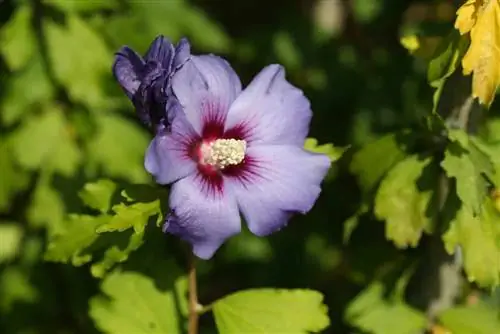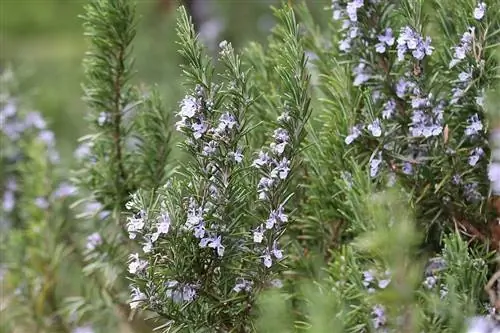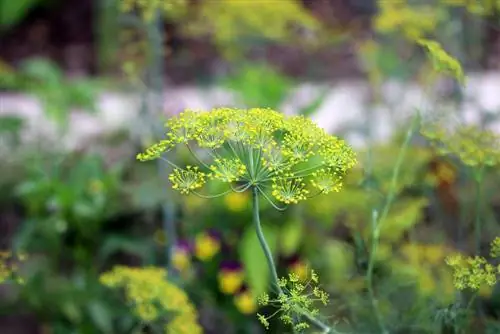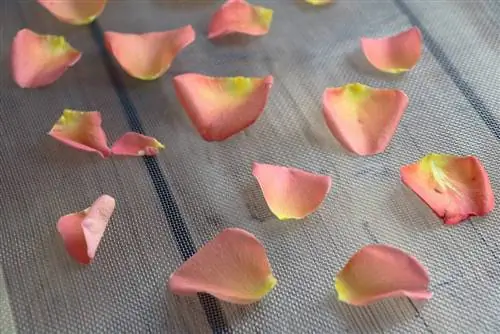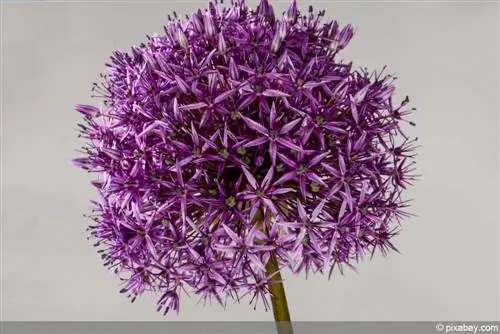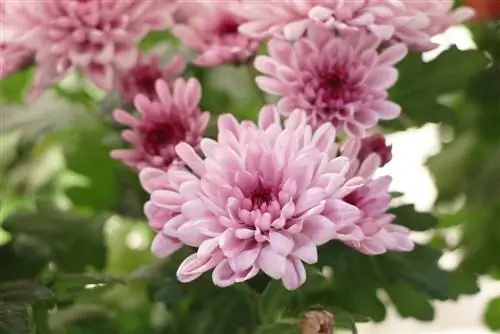- Author admin [email protected].
- Public 2023-12-17 03:39.
- Last modified 2025-01-24 12:45.
Whether you grow a hibiscus in the garden or as a houseplant, the flowers are simply magnificent. The plant, which comes from Asia, belongs to the mallow family. More than 500 species are known. In Germany, the rose marshmallow is very popular as a house or container plant and the garden marshmallow is very popular in outdoor cultivation. Which flowers are edible and how are they prepared?
Edible Hibiscus Flowers
Modern marshmallows produce decorative funnel-shaped flowers from spring to fall. New varieties are available with double flowers. The decorative flowers of the hibiscus are not only an eye-catcher, some varieties are edible. You can eat them raw or cooked or use them to decorate drinks, cakes and desserts. To preserve them, you can also put the marshmallow flowers in syrup.
Chinese rose marshmallow (Hibiscus rosa-sinensis)
The evergreen Chinese rose marshmallow has been the national flower of Malaysia since 1960. A red hibiscus flower can be seen on the state coat of arms. In Germany it is also known as the Chinese rose. Hibiscus rosa-sinensis is not suitable for outdoor use. It prefers a warm location, but should not be exposed to the blazing sun. In summer he also feels very comfortable on the balcony.
The magnificent, partially double flowers can be used raw to decorate food and drinks and eaten. The flowers of the Chinese rose marshmallow are considered to be anti-inflammatory. They are used in dried form for tea preparations. Rose marshmallow flowers are particularly colorful. This property is used to color food.
- Flowers: white, yellow, orange, red with red stamens and yellow stamens
- Flowering period: June to August
- Height: up to 1.5 meters high
- Cultivation: Houseplant
- Pruning: Pruning in winter to stimulate flowering
- Location: warm, moist, repot every 3 years
- Overwintering: in a protected, shady location in the house
Tip:
All types of hibiscus require a lot of moisture. Waterlogging must be prevented by ensuring good water drainage. Especially with houseplants, waterlogging is the most common cause of failure to bloom.
Roselle (Hibiscus sabdariffa)
The roselle also goes by the names Sudan marshmallow or African mallow. It is an outstanding species of hibiscus native to Asia. In their homeland, roselle flowers are used in the production of desserts, liqueurs and lemonades. When dried, its flowers can be used to make a tasty and he alth-promoting tea. Tea made from roselle flowers stimulates the circulation, has a diuretic effect, prevents colds and helps with the desired weight loss.

It is used successfully against depressive moods in women during menopause. In Senegal, the tea is served ice-cold with lots of sugar under the name “Bissap”. In Trinidad, roselle calyxes are mixed with cloves, cinnamon and sugar to make a syrup that is used as the basis for numerous cocktails and cold drinks.
- Flower: bright red
- Flowering time: August to September
- Height: up to 3 meters high
- Cultivation: in Germany only in greenhouse
- Location: warm, humid
- Pruning: Pruning from the end of March
- Overwintering: protected in the greenhouse
Marshmallow (Hibiscus syriacus)
The marshmallow, which is widespread in German gardens, is also known as the Sharon rose or festival flower. This variety has adapted perfectly to the Central European climate and pampers us with its wonderful flowers with minimal care required. The flowers, which reach a diameter of up to 7 centimeters, usually have a dark red center.
Shrub marshmallows are ideal for planting in containers. The flowers of Hibiscus syriacus can be used to decorate cocktails or sparkling wine. You can eat them raw or cooked. They are a real eye-catcher on desserts!
- Flower: white, pink, purple, blue, violet, dark red in the middle
- Flowering time: July to September
- Height: up to 4 meters high
- Cultivation: outdoors or as a container plant
- Location: warm, humid
- Pruning: Training or maintenance pruning in spring
- Overwintering: outdoors, protecting the roots with a layer of mulch or brushwood
Swamp Marsh Marshmallow (Hibiscus moscheutos)
A real insider tip among Germany's hobby gardeners is the marshmallow, the Hibiscus moscheutos. With its huge flowers, which can reach a diameter of up to 30 centimeters, it is also called giant hibiscus. The bushy growing plant feels at home in full sun in the garden. The giant hibiscus requires nutrient-rich soil.
You can eat the beautiful flowers, use them to refine salads or dry them to make tea. A salad with Hibiscus moscheutos flowers looks great and is very he althy due to the high vitamin C content.
- Flower colors: white, pink, red
- Flowering time: July to October
- Height: up to 2 meters high
- Cultivation: Outdoor or container plant
- Location: very sunny, warm, humid
- Pruning: in late autumn
- Soil: rich in humus
- Overwintering: outdoors with winter protection
Make hibiscus tea
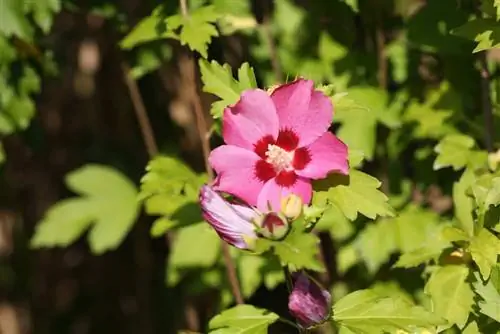
Tea made from hibiscus flowers can be enjoyed cold or hot, pure or mixed with rose hips. The high vitamin C content makes the flowers a real superfood. With its sour taste, hibiscus flower tea is very refreshing.
Instructions
- Lay out the flowers on kitchen paper and dry them
- turn several times
- keep dried and sealed in jars
- pour boiling water over about a handful of dried flowers
- Let it steep for 6 to 8 minutes
- enjoy hot or cold
Note:
Use only the flowers of unsprayed plants to make tea, syrup and salad or for decoration.
Make hibiscus flower syrup
Hibiscus flower syrup can be made yourself with little effort. A small amount of syrup mixed with water gives you a refreshing drink at any time. Delicious cocktails or sparkling wine can be refined with a few splashes of hibiscus flower syrup.
Instructions for 350 milliliters of syrup:
- Bring 0.5 liters of water to the boil
- Add 20 grams of dried hibiscus flowers, a lemon slice and 150 grams of syrup sugar
- Bring the mixture to the boil briefly
- Let it steep for 24 hours
- season with cloves or cinnamon
- strain through a cloth
- fill into small bottles using a funnel
The deep red hibiscus flower syrup is filled into decorative bottles and makes a great gift. If you want to put fresh hibiscus flowers in the syrup, you should use small jars instead of bottles so as not to damage the flowers. It also looks very decorative if you place a hibiscus flower in light elderflower syrup.
Tip:
Gin Tonic with a hibiscus flower in the glass is a real eye-catcher. The drink benefits from the sour taste and the slight red color.
Salad with hibiscus flowers
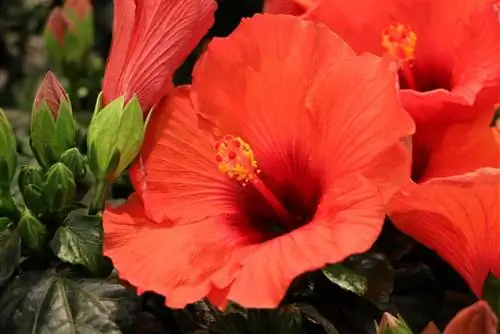
You can use hibiscus flowers like lettuce in a salad. An unusual idea is to not only mix the salad with crushed flowers, but also to present the salad in giant hibiscus flowers.
Instructions
- Prepare salad from garden vegetables as desired
- cut fresh hibiscus flowers into strips, add
- Place giant hibiscus flowers in a shallow glass bowl
- Fill in salad
Decorate cakes with hibiscus flowers
Decorating cakes with edible flowers is a great idea for all hosts looking for a surprise. Quark cakes are particularly suitable.
Instructions
- Wash the flowers
- dry carefully with kitchen paper
- place on the cake
- keep in the fridge
Note:
“A lot helps a lot”, this wisdom does not apply when decorating cakes and desserts with hibiscus flowers. Even a single flower in the middle attracts everyone's attention.

